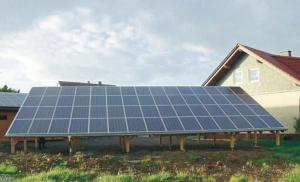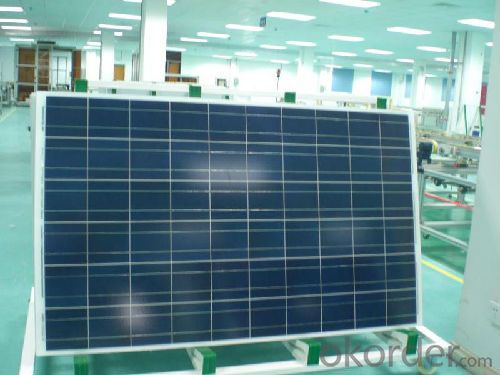Solar Panels with High Quality 250W Poly Solar Panels with High performance 250W Solar Modules
- Loading Port:
- China main port
- Payment Terms:
- TT or LC
- Min Order Qty:
- 50 pc
- Supply Capability:
- 10000 pc/month
OKorder Service Pledge
OKorder Financial Service
You Might Also Like
1.Structure of Solar Module Description
CNBM Solar's photovoltaic module is designed for designed for large electrical power requirement. It is the optimal choice for both on-grid and off-grid power systems. CNBM Solar offers high performance of power per square foot of solar array.
2.Main Features of the Solar Module
Solar Cell: High efficency crystalline solar cell. Even if under the weak light, the solar module can produce maximum power output.
Tempered glass: Anti-reflecting coating and high transmission rate glass increase the power output and mechanical strength of solar module.
EVA and TPT: Using high quality EVA and TPT to prevent destroying and water.
Strong aluminum frames to strengthen the load hold and to stand against high wind.
Junction box: Multi function junction box with water proof.
Long lifetime: ≥25 years; Less power decrease.
Good performance of preventing from atrocious weather such as wind and hails.
Resisting moisture and etching effectively, not effected by geology.
The certificate issued by international authority: UL, TUV, IEC, VDE, CE.
Quick Details
| Place of Origin: | Taiwan | Brand Name: | CNBM | Model Number: | TP-P 250W |
| Material: | Polycrystalline Silicon | Size: | 1640*992*45mm | Number of Cells: | 60PCS |
| Max. Power: | 250W | solar cells: | 60pcs | colour: | black, blue |
Packaging & Delivery
| Packaging Detail: | 2pcs/box, 18boxes/pallet |
| Delivery Detail: | 10-12 days |
3.Solar Module Images
4.Solar Module Specification
1. 250W Poly Solar Panel
2. with Brand Cells inludes Yingli, NSP, Bosch, Sunpower Solarworld etc
3. TUV, IEC, CE, ETL Msc
250 watt solar panel, Poly solar modules 250W,250w panels solar
5.FAQ of Solar Module
1. Q: Do you have your own factory?
A: Yes, we have. Our factory located in Jiangyin city, jiangsu province.
2. Q: How can I visit your factory?
A: Before you take off from your country, please let us know. We will show you the way,or arrange time to pick you up if possible.
3. Q: Do you provide free sample?
A: Usually we do not offer free sample
4. Q: Could you print our company LOGO on the nameplate and package?
A: Yes, we can do that.
- Q:For example, If I were powering my house with solar panels, would it be more efficient or effective, (or I guess would I get more energy) out of a day that measured 90 degrees Fahrenheit as opposed to a day that is 70 degrees Fahrenheit.
- Nope. Sunlight is.
- Q:How do solar panels affect the overall air quality of a building?
- Solar panels have a positive impact on the overall air quality of a building. They generate electricity by harnessing solar energy, which is a clean and renewable source. By using solar panels, buildings can reduce their dependence on fossil fuel-based power sources, such as coal or natural gas, which produce harmful emissions. This reduction in greenhouse gas emissions helps to improve the air quality, making the building more environmentally friendly and sustainable.
- Q:I would love to put in solar panels on my roof, but how hard would it be, and how expensive? Would I be able to do the work myself, or would I have to hire a pro?Also I live in Oregon, so much of the time it is overcast, so would it really be worth it?
- Not worth it unless you can get a fat subsidy. But Congress is working on a bill to provide a significant subsidy, and Oregon may have one as well. A solar plant costs about $0 per watt of installed capacity, and can produce a maximum of two kWh per watt per year -- which is worth about two bits. Without a subsidy, you are better off leaving your money in a savings account.
- Q:Photo-Voltaic solar panels are very expensive. Most of a home's energy needs are for heating water, heating and air-conditioning. All of these can be met with thermal solar collectors which are much less expensive. The thermal solar panels would heat water stored in a hot water tank which then can be used as hot water, to heat the home, or as the heat source to a Lithium Bromide Absorption chiller to air-condition a home. With the base line needs met without expensive panels and without inefficient energy conversions, only a small Photo-Voltaic array would be needed for the remaining power needs and since those needs are variable, there would still be power to sell to the grid.
- I agree with you John and for the same reason already put forth as a negative. Solar thermal is a more mature technology. This is the reason why I spent so much of the last winter studying it. I can be reasonably sure that what I learn will not be obsolete tomorrow with a new technological breakthrough. I built a solar addition/greenhouse to personally study the effects. So solar thermal panels are not the only way to go. With respect to electrical production. I have seen parabolic reflectors coupled to stirling engines and solar thermal trough heaters used to supplement steam generation for alternatively gas fired steam / electrical generation plants. On a trip to China over 4 years ago I noticed solar hot water vacuum tube collectors being sold in their local hardware and big box style stores. These were gravity fed package units intended to have the tank on the roof with a supplemental electric backup. The vacuum tube collectors seem to be one of the latest innovations in this technology. Using phase change materials temperatures in these panels can be produced in excess of 400 deg F. and they are useful in colder temps and on cloudy days. While they are still costly for many applications, I have been discussing the use of vacuum tube collectors with the owner of a laundrymat. Solar thermal will not pay back as well as conservation in many cases of older construction, but it currently seems better than photovoltaic panels. Solar thermal requires more understanding of systems and relative efficiencies. In one way solar thermal is more like the electric car while the internal combusion engine is like photovoltaic. The idea of producing electricity from the sun is a sexier idea. It is also more in line with our paridigm of: just producing lots of energy and to H with any conservation efforts. For that reason it seems to get more press.
- Q:Im curious because I read about a boy who invented a 3d solar panel, using a pyramid he designed a solar panel that collects light more efficiently. Now I have a question. Why cant I design a solar panel that takes adventage of convex and concave mirror's and use a surface that collects light and then focus's the suns energy into a beam and take the beam into a chamber where the solar panels are sitting and surround them with mirrors as well, so any light not obsorbed by one particular spot is reflected to another area for reabsorbtion. I know solar panels dont absorb light but perhaps that will allow more light to create the effects it needs.
- I don't know anything about the 3D thing. You cannot get more energy out, than goes in. Energy will only hit the mirrors. With some loss of efficiency they would reflect a focused beam into the chamber, where with some more losses would reflect it to the solar panels. It would be more efficient just to expose all the panels to sunlight.
- Q:Do solar panels require permits for installation?
- Yes, in most cases, solar panels require permits for installation. The specific requirements and regulations vary depending on the location, but obtaining permits ensures that the installation meets safety standards and compliance regulations set by local authorities.
- Q:I am starting to think about solar panels as an option for my home. I have done some research on panels, to be honest its all very confusing. There are many different panels some with 60 watts some all the way up to 20 watts. My household currently uses about 2700 to 3400 kWh every two months. So based off of my power usage maybe you can answer some of the following questions:What kind of panels should I be looking at?Which panel manufacturers give the best bang for the buck (reliable/affordable)?Anything else I should be concerned about?I am just starting out in educating myself on solar power so please excuse me if I sound very naive. Any information that you may have will be helpful. Thanks in advance.
- solar cell is a solar cell solar panel are many solar cells.... Typically people refer to a single solar panel as a solar panel, even though they should be reffering to it as a solar cell. A solar panel is a panel of solar cells working in conjunction with each other. I hope that makes sense it is just the incorrect terminology people always use.
- Q:Can solar panels be used for satellite communication?
- Yes, solar panels can be used for satellite communication. Solar panels are often used to power satellites as they can convert sunlight into electricity. This generated electricity can then be used to operate various communication systems and equipment on board the satellite, enabling satellite communication.
- Q:What do I need to use this as a battery charger
- I hope this will help you choose your charge controller / battery charger more effectively. Good luck!
- Q:Can solar panels be easily removed and relocated?
- Yes, solar panels can generally be easily removed and relocated. Since solar panels are not permanently fixed to the ground or roof, they can be disassembled and moved to a new location if needed. However, the ease of removal and relocation may vary depending on the specific installation and mounting system used.
1. Manufacturer Overview |
|
|---|---|
| Location | |
| Year Established | |
| Annual Output Value | |
| Main Markets | |
| Company Certifications | |
2. Manufacturer Certificates |
|
|---|---|
| a) Certification Name | |
| Range | |
| Reference | |
| Validity Period | |
3. Manufacturer Capability |
|
|---|---|
| a)Trade Capacity | |
| Nearest Port | |
| Export Percentage | |
| No.of Employees in Trade Department | |
| Language Spoken: | |
| b)Factory Information | |
| Factory Size: | |
| No. of Production Lines | |
| Contract Manufacturing | |
| Product Price Range | |
Send your message to us
Solar Panels with High Quality 250W Poly Solar Panels with High performance 250W Solar Modules
- Loading Port:
- China main port
- Payment Terms:
- TT or LC
- Min Order Qty:
- 50 pc
- Supply Capability:
- 10000 pc/month
OKorder Service Pledge
OKorder Financial Service
Similar products
New products
Hot products
Related keywords
































